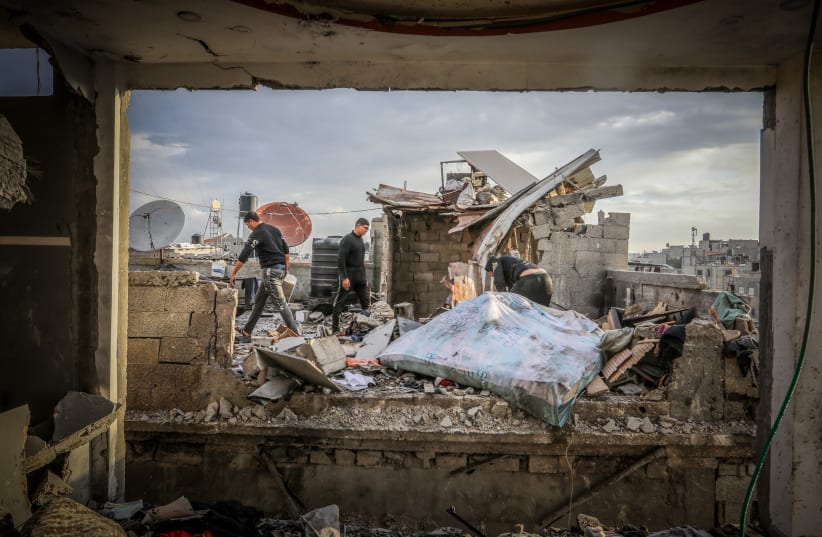Some 99% of these emissions were attributed to Israel’s aerial and ground operations against Hamas in Gaza.
By MAAYAN JAFFE-HOFFMAN JANUARY 14, 2024

A new global study revealed that the carbon dioxide (CO2) emissions generated in the initial 60 days of the Israel-Hamas conflict surpassed the annual emissions of 20 countries identified as highly vulnerable to climate change.
The report, published last week on the Social Science Research Network, tried to analyze the war’s effects on carbon emissions. The researchers found that from October 7, when Hamas attacked Israel, to December 4, some 281,000 metric tons of carbon dioxide were released. This is equivalent to burning 150,000 tons of coal annually in 75 coal-fired power plants.
Some 99% of these emissions were attributed to Israel’s aerial and ground operations against Hamas in Gaza.
The analysis, which has still not been peer-reviewed, includes CO2 emissions from Israeli bombing raids, primarily carried out by F-16 fighter jets, tanks, and other military vehicles, cargo and patrol flights, and the emissions of the estimated munitions used by Israel against Hamas.
The study found that the emissions of US cargo planes delivering military supplies to Israel accounted for almost half of the total emissions. Up to December 4, the US sent around 200 cargo flights carrying 10,000 tons of supplies to Israel. These planes emitted 133,000 tons of CO2, the report showed.
The research does not include other greenhouse gas emissions, such as methane. It does include CO2 emissions from Hamas rockets targeting Israel. The researchers found that the 9,500 Qassam rockets Hamas fired on October 7 generated 713 tons of CO2 over several weeks, about the equivalent of burning 300 tons of coal.

“There is very clearly an emissions asymmetry here, in the same way, that there are a lot of asymmetries in this conflict,” said Patrick Bigger, research director of the Climate and Community Project US-based think tank, who co-authored the study.
Hamas’ tunnel network emits more than Tonga
The study also included emissions generated by Hamas to build its 500-kilometer underground tunnel network, estimated to be an additional 176,000 tons – more than the island nation of Tonga emits annually.
Benjamin Neimark, a senior lecturer at Queen Mary University of London (QMUL) and a co-author of the study, told The Jerusalem Post that it was nearly impossible to get an understanding of emissions by Hamas because of the “ad hoc nature of Hamas’s offensive capabilities.” It is not clear how Hamas resupplies its weapons, he said.
The study also does not include the emissions for transporting the thousands of trucks of aid supplied to the Gaza Strip since the start of the war.
Neimark said the emissions appear high but are comparable to those in other wars the team or their colleagues have studied, such as the Iraq war. At the same time, he stressed that the emissions are a gross underestimate, given the number of high-emissions acts being committed that they cannot track.
In the paper, the researchers list eight areas that they were not able to include in the study, from fires resulting from explosions to the clearing of debris.
The authors additionally sought to assess the carbon footprint associated with the reconstruction of Gaza post-war. Their estimate suggested that rebuilding 100,000 destroyed buildings would incur a carbon cost of 30 million metric tons, equivalent to the annual carbon emissions of New Zealand – far more than has been emitted thus far.
Separate reports have shown that about 85% of the Gazan population has been displaced – close to 1.8 million people. Moreover, at the time of the study, between 36-45% of Gaza buildings had been destroyed or damaged, the report indicated. A report by the Wall Street Journal earlier this month claimed that almost 70% of Gaza homes were damaged or destroyed.
The study’s emissions estimate is based on reconstructing residential and commercial buildings at three to five stories and schools, hospitals, and industrial buildings at two stories.
According to Israeli experts, in addition to general reconstruction, Gaza will be largely uninhabitable at first due to environmental risks, such as organic and non-organic waste, sewage, and toxic chemicals seeping into the soil, groundwater, and sea. Abandoned homes could also become the targets of disease-causing mosquitoes, flies, and other pests.
“Israel is defending itself against a murderous terror organization that commits war crimes and crimes against humanity and sexual crimes against Israeli women and holds 136 hostages for over 100 days,” Foreign Ministry Spokesperson Lior Haiat told the Post in response to the study.
“This responsibility of the government of Israel is for the security of its citizens, and we will continue to fight against Hamas under international law until we eliminate Hamas from the Gaza Strip and release every one of the hostages,” he said.
Climate activists have been protesting against the war in Gaza under the slogan “no climate justice without peace.”
Neimark and Bigger said that they were pushing for a ceasefire due to the loss of human lives on both sides and not because of the war’s environmental impact. However, in a Zoom call and their paper, they also stressed that “military operations remain an under-analyzed dimension of the climate crisis that will intensify suffering on vulnerable communities as the impacts of global warming intensify.”
They said that military emissions are “insufficiently accounted” for by the United Nations Framework Convention on Climate Change (UNFCCC) in that carbon accounting by militaries remains voluntary, and most do not report their emissions. The authors estimated that around 5.5% of total carbon emissions are from militaries, more than double the proportion attributable to commercial airlines.
“Whether an emission comes from an act of self-defense or from making ice cream or powering a hospital, the atmosphere doesn’t care,” Bigger said. “If we are going to get a handle on the climate crisis, we have to have a fuller understanding of the emissions sources.”
https://www.jpost.com/environment-and-climate-change/article-782168
